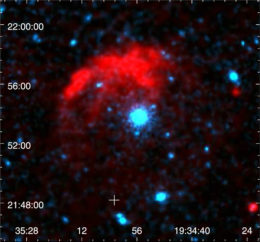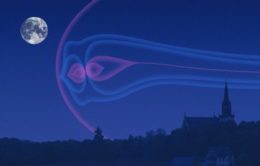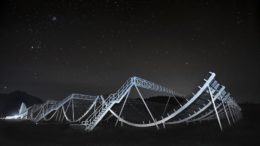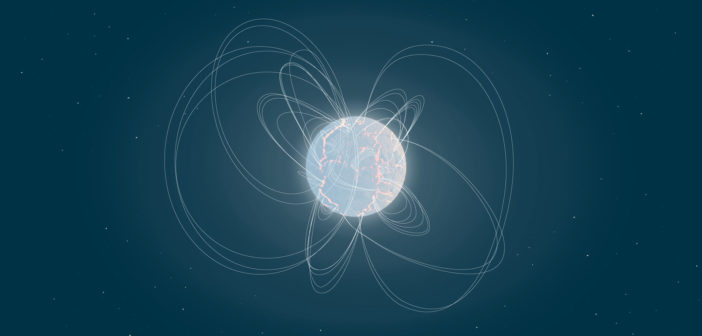Astronomers are starting to close in on the origins of fast radio bursts — powerful, fleeting flashes of radio waves seen at extragalactic distances. Highly magnetized neutron stars called magnetars might be responsible for many of these far-flung events, but how exactly do these extreme objects generate fast radio bursts?
A Cosmic Conundrum

X-ray and radio observations of the magnetar associated with the first fast radio burst seen in our galaxy. The magnetar is the bright blue X-ray source in the center of the supernova remnant. [Zhou et al. 2020]
In today’s article, Andrei Beloborodov (Columbia University and Max Planck Institute for Astrophysics, Germany) explored whether a fast radio burst generated close to the surface of a magnetar could escape the confines of its magnetosphere — the region of space where charged particles bend to the will of the magnetar’s intense magnetic field.

Illustration of the size of Jupiter’s magnetosphere on the night sky. Although a magnetar’s magnetosphere is physically smaller, its magnetic fields are far stronger. [NASA/ESA]
Magnetar Models
Magnetospheres have great importance within our solar system — Earth’s magnetosphere shields us from energetic particles generated by the Sun, and Jupiter’s magnetosphere would dominate the sky if our eyes were adapted to see radio wavelengths. The magnetosphere of a magnetar, though, is far stranger than these nearby examples; the magnetized neutron star at the center generates a plasma of electrons and their positively charged counterparts, positrons, that fills the magnetosphere and might prevent a radio burst generated near a magnetar’s surface from escaping into space.
Beloborodov used plasma physics equations to understand how a radio burst might interact with the charged particles and magnetic fields within a magnetar’s magnetosphere. As the radio burst travels outward, it compresses the magnetosphere, transferring its momentum to the magnetic fields and the plasma. The oscillating electrons and positrons emit gamma rays that can collide to produce even more electrons and positrons — creating a cascade of particles and gamma rays that scatter the radio wave and sap its energy. For the radio wave, there’s no escape; Beloborodov found that it’s extremely unlikely that a fast radio burst could escape the magnetosphere’s grasp if it were generated within 100,000 km of the magnetar’s surface.
More to Learn

Photograph of the CHIME radio telescope in British Columbia. [Andre Renard/Dunlap Institute/CHIME Collaboration]
Luckily, the Canadian Hydrogen Intensity Mapping Experiment (CHIME) is poised to add new observations to its existing catalog of hundreds of fast radio bursts, helping us to understand the sources of these mysterious events and the complex physics behind them.
Citation
“Can a Strong Radio Burst Escape the Magnetosphere of a Magnetar?,” Andrei M. Beloborodov 2021 ApJL 922 L7. doi:10.3847/2041-8213/ac2fa0

